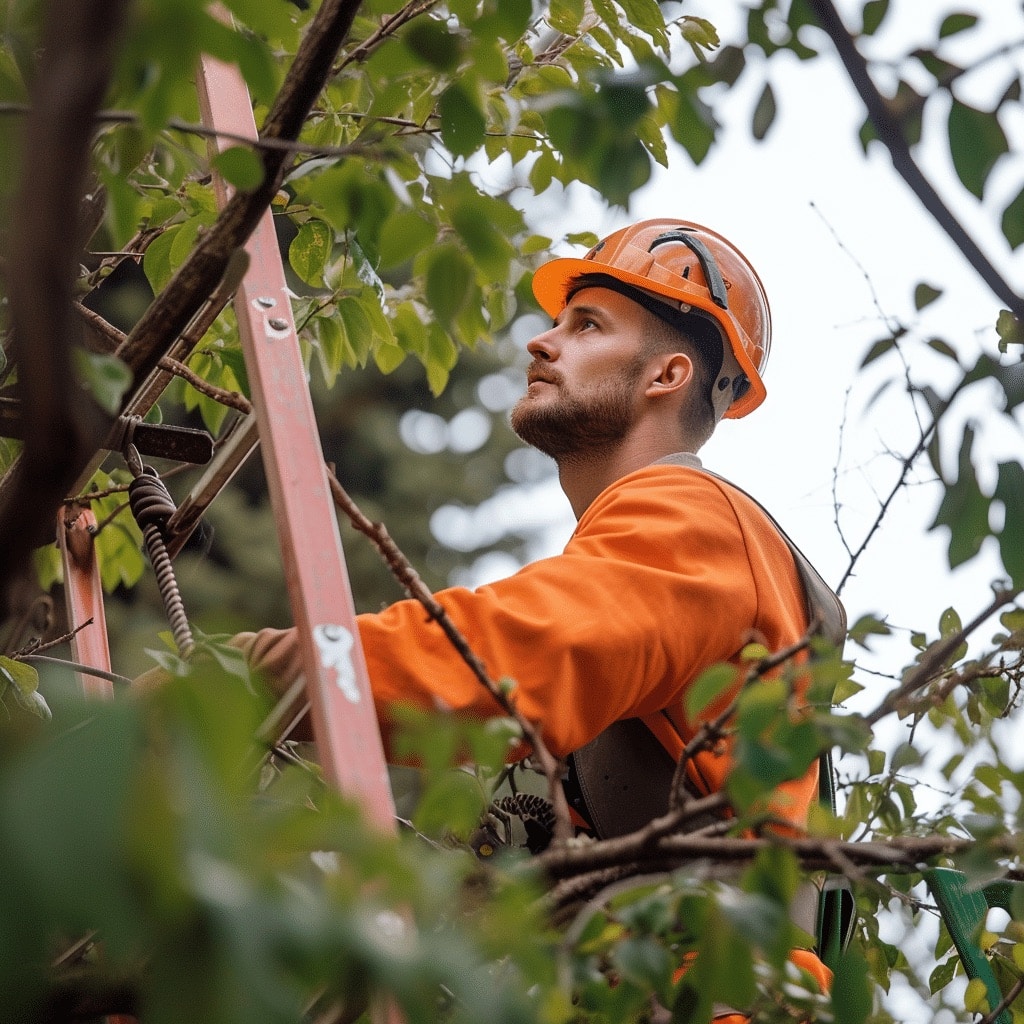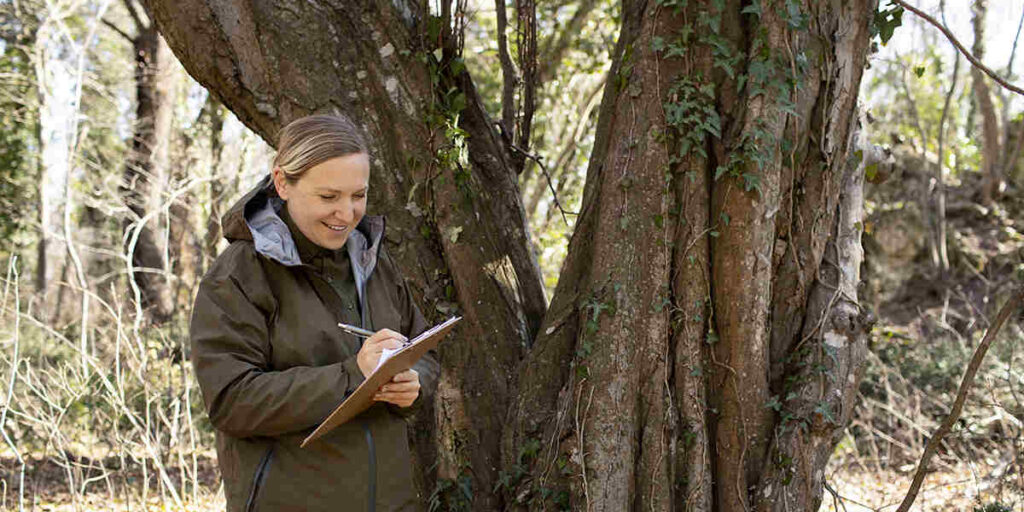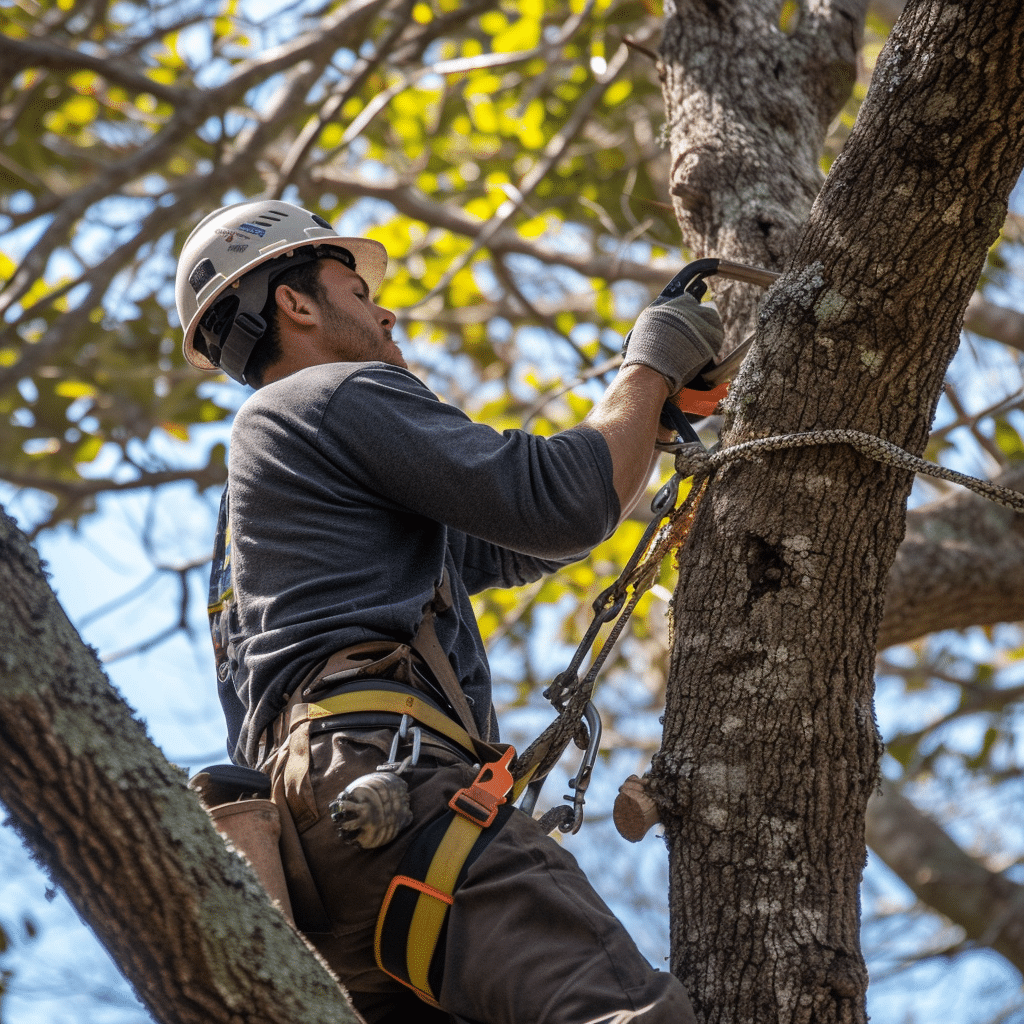By: Shelby McCullough| Published: January 15, 2024
As admirers of nature’s towering wonders, we understand that trimming palm trees is as much about safeguarding their health as it is about maintaining their tropical appeal. A well-groomed palm can uplift the aesthetics of an entire landscape, but hasty or unsuitable trimming can endanger this invaluable resource. This guide helps demystify palm tree maintenance so that pruning becomes less about endurance and more about love for these majestic plants.

Timing and technique are paramount when it comes to palm tree pruning. Over-pruning can distress the tree, whereas inadequate trimming can lead to the growth of pests or disease. Additionally, the effectiveness of pruning is significantly shaped by the season – properly timing your trimming efforts can greatly improve the palm’s recovery and overall health.
Key Takeaways
- Palm tree trimming is not only about aesthetics, but health and safety of the tree.
- Over-pruning can distress a palm tree and limit its growth.
- Under-pruning may lead to an increase in pests and disease.
- Proper timing of the pruning process influences the recovery and health of the tree.
Understanding the Need for Trimming Palm Trees
Palm tree care is vital to maintain the natural beauty of these tropical features. Keeping them healthy and attractive requires following effective palm tree trimming techniques. Not all palms may need trimming; as such, a clear understanding of the palm’s health, potential safety risks, and optimum timing for trimming is crucial. This insight helps ensure programmed maintenance aligns with the tree’s natural growth cycle, contributing to its overall vitality and longevity. So, when should you consider trimming your palm?
Assessing the Health of Your Palm
The first step in professional palm trimming involves careful observation of the tree’s condition. Dying or wilted fronds, discolored spots, or indications of potassium deficiency, such as yellow spots, all imply a need for trimming. Removal of broken fronds can prevent potential damage to people or nearby property. Moreover, trimming palm flowers and fruits that are unnecessarily draining the tree’s resources also contributes to its overall health.
Identifying Safety Risks Involving Nearby Structures
Palm fronds can present safety hazards if they get too close to buildings or impede public pathways or roads. During high winds, such fronds could cause significant damage. Identifying these potential risks and planning a trim keeps the environment safe while maintaining the palm’s lush appearance. Reputable tree care services are adept at handling such challenges, ensuring both palm health and safety standards are met.
Timing Your Trimming: Seasonal Considerations
Just as with many aspects of gardening, timing plays a crucial role in palm tree management. The tree’s rapid recovery and enhanced resistance against diseases make late spring or warmer months the best period to carry out palm tree trimming. Proper timing, paired with correct techniques, significantly contributes to the tree’s vitality and attractiveness. It allows the palm to better redirect its energy towards healthy foliage production.
Preparing for the Trimming Process
Before we dive right into trimming those palm fronds, there are some crucial steps we need to follow to ensure that our palm tree trimming services are successful and safe. Firstly, we need to gather the right tools for the task and make sure they are both sharp and sterilized. You might ask, why the sterile part? It’s simply because sterilizing pruning tools is an integral part of preventing the spread of diseases between trees. A popular method we use for sterilization involves a simple bleach and water solution.

Once we are armed with our sterilized tools, it’s time to set up a safe climbing structure. Regardless of whether we use a sturdy ladder or another type of climbing apparatus, our goal is to ensure stability and safety while trimming the palm fronds. It is also imperative that whatever climbing gear we use does not damage the tree’s trunk by bending or puncturing it.
Apart from the safety of our crew and the tree’s health, we also give careful consideration to the environment. With this in mind, we have a plan for disposing of the trimmed fronds and any accompanying organic waste. Our strategy takes into account local disposal guidelines to ensure we do our bit for Mother Nature.
To give you a clearer idea of how we approach the trimming process, here is a step-by-step breakdown:
- Gather necessary tools.
- Ensure tools are sterilized and sharp.
- Set up a stable and secure climbing structure.
- Plan for the eco-friendly disposal of organic waste.
Taking these steps ensures the process of providing palm tree trimming services is both effective and kind to the environment.
Selecting the Proper Pruning Equipment
When it comes to palm tree pruning, employing the right tools can make all the difference. The process can be made safer and more effective with carefully chosen and well-maintained equipment. In the world of a tree trimming company, the tool kit varies to cater to different types of trees and their varied branches or fronds. For palm trees specifically, there are various tools that are found to be particularly useful.
The size of the palm fronds is the primary determining factor to aid in selecting your tool. For smaller fronds, a serrated knife or large clippers could be sufficient. If the fronds are quite large and hard, you might have to opt for a hand saw or, in some cases, a chainsaw.
| Frond Size | Suitable Equipment |
|---|---|
| Small | Serrated Knife or Large Clippers |
| Medium | Hand Saw |
| Large | Chainsaw |
Maintaining the cleanliness of your tools is crucial in preventing the spread of soil-borne diseases. We recommend disinfecting your tools with a household cleaner or a bleach solution before every use. Sharpen the blades with a whetstone or oilstone for optimal cutting results.
In summary, the key to successful and healthy palm tree pruning lies in picking the right equipment and preparing it thoroughly for the task. It is a small effort in comparison to the significant benefits it will bring both for you and your much-loved palm trees.
Ensuring Safe Climbing Practices
Trimming palm trees, particularly the taller specimens, often necessitates climbing. The key to ensuring that this activity doesn’t compromise the tree’s health or the trimmer’s safety lies in the selection of appropriate climbing gear and following best climbing practices. As some of the best palm tree trimmers, we take the intricacies of this task seriously to maintain the highest standards of safety and efficacy.
Choosing the Right Climbing Gear
For palm trees that extend up to 15 feet in height, a sturdy and well-constructed extension ladder would typically suffice. However, for taller specimens, it becomes imperative to deploy professional climbing gear like a bucket lift or cherry picker. Safety harnesses can be beneficial in ensuring secure ascent and descent while trimming, but these should exclusively be operated by trained professionals to avoid mishaps.
Avoiding Damage to the Palm Tree Trunk
It’s not just climber safety that’s a concern when scaling a palm tree. The tree itself can suffer harm in the process, which makes following the right palm tree trimming techniques crucial. We strongly recommend against the use of spikes or cleats for climbing, as they can seriously harm the palm’s trunk, creating unnecessary entry points for diseases and pests. A better practice is to brace the tree using lumber supports, especially if it’s a newly grown tree that needs additional stability against strong winds. This not only maintains the structural integrity of our beautiful palms but also allows for safer trimming without causing inadvertent harm to the tree.
By ensuring the proper use of climbing gear and following these safety practices, we can keep both the palm trees and the individuals conducting the trimming in peak condition, ready to weather the challenges of the next climb!
Donning the Appropriate Safety Gear
When it comes to trimming palm trees, no step in the process can be taken lightly; this includes the very crucial step of ensuring safety for the individual performing the task. Given the nature of the work, it is essential to gear up appropriately to protect oneself from potential harm. This segment provides information on the essential safety gear required for the task and the proper way to use it.
Protecting Your Hands and Eyes
You’re likely to encounter sharp edges and flying debris when trimming palms. Therefore, donning protective gloves and safety goggles is non-negotiable. Gloves provide a firm grip and shield your hands from cuts and scrapes, while safety goggles protect your eyes from harmful dust particles and potential flying hazards. Remember, taking precautions is the first step to ensuring safe palm tree maintenance.
Using Safety Equipment Correctly
In the world of professional palm trimming, using safety gear correctly is of utmost importance. Working with larger trees or hefty power tools means wearing a sturdy helmet to protect against falling frond or unexpected movements. Also, when using powerful machines like chainsaws, make sure to operate them safely and responsibly to avoid accidents. Ensuring that the safety gear is used the right way will allow the person carrying out the tree care service to operate without the worry of personal injury, and they can concentrate fully on the task at hand. Stay safe!
| Safety Gear | Purpose | Usage |
|---|---|---|
| Gardening Gloves | Protects hands from cuts and gives a firm grip on tools | Wear at all times during trimming |
| Safety Goggles | Shields eyes from dust particles and flying debris | Wear before starting the work and keep on throughout |
| Helmet | Protects head from falling fronds and unexpected movements | Essential when working with big trees or chainsaws |
Palm Tree Pruning Techniques
With the right techniques, caring for your palm tree can be an effortless task. Proper pruning not only enhances the physical appeal but also contributes to the overall health of the tree.
In the realm of palm tree trimming services, it’s essential to focus on the removal of only dead or damaged fronds. Undue removal can cause harm to the tree. However, the process is a delicate balancing act that requires in-depth knowledge.
Mature fronds often grow below the recent year’s crop. These should typically be retained with at least two rows of mature fronds left intact. The idea is to let the tree continue its natural growth cycle without unnecessary disruption.
Any green fronds that dip below a 90-degree angle to the ground are generally safe to remove. This action helps maintain the aesthetic appeal of the tree without causing any harm to its overall health.
The cardinal rule of trimming palm fronds is to ensure the cut is made a minimum of two inches from the trunk. Any closer might damage the trunk, leading to potential health problems for the tree.
The crown of the palm is its lifeline. No matter how overgrown it appears, removing it will inevitably result in the death of the tree. So, its preservation is non-negotiable.
Adhering to these norms ensures a healthy growth cycle for your palm tree. Giving it the care it deserves will not only add to its lifespan but also to the beauty of your landscaping.
Remember, a healthy palm is a happy palm.
Trimming Palm Trees: Step by Step
When it comes to maintaining the health and aesthetics of your palm trees, employing the correct palm tree trimming techniques is vital. It’s more than just randomly snipping away at the fronds – it’s a process that needs to be strategic and carefully executed. Let us walk you through this step-by-step.
-
Begin by thoroughly assessing the tree. This will give you a clear understanding of which fronds and petioles (blades of fronds) require removal. Keep an eye out for any signs of damage or disease, such as browning, withering, or signs of insect infestations.
-
Trim away the dead or broken fronds. However, be cautious to avoid trimming the healthy, green fronds, especially those that hold an upright position and are positioned above a horizontal line.
-
Also keep a watch on the flowers and developing fruit, if any. It’s good practice to prune these to not only conserve the tree’s energy but to also minimize the risk of falling debris and to control the attraction of pests.
-
Finally, once the trimming is done, let the tree heal and restore its energy. Avoid any additional pruning for at least a year. This gives the tree ample time to recover and work on producing healthy foliage.
Keep in mind that the frequency and intensity of the trim will vary depending on the species, age, and health of your palm. When in doubt, it’s always a good idea to hire professional tree care services to handle the task; this not only ensures the job is done accurately but also guarantees the continuing health of your tree.
The Importance of Sterilizing Pruning Tools
Providing optimal palm tree maintenance goes beyond the mere act of pruning. The proper conditioning of trimming equipment is crucial for ensuring the overall health and longevity of our beloved palm trees. To achieve the highest quality of professional palm trimming, we must emphasize the importance of sterilizing our pruning tools. This practice prevents the transmission of potential diseases between trees and amplifies the effectiveness of our pruning efforts.
Preventing Disease Transmission
Trimming tools come into direct contact with the intricate anatomy of our palm trees. Without proper hygiene, these tools can become carriers of harmful diseases, moving pathogens from one tree to another with each snip. Before starting, we ensure that all pruning gear, including chainsaw components, is wiped clean of dirt and debris. This simple act significantly decreases the chances of disease transmission.
Maintaining Tool Hygiene and Effectiveness
After initial cleaning, it is essential to soak our pruning equipment in a proper sanitizing solution. A mixture of water and bleach is often an effective and readily available option. Rust on metal parts, a common culprit for contaminating our beloved palms, can be removed with a wire brush. For additional safety, we recommend disinfecting the tools with a household cleaner or alcohol.
After soaking, it is essential to rinse the tools with water and air-dry them. This process ensures that our tools are not only clean but also free from moisture, which could otherwise cause oxidation or promote the growth of harmful fungi. Maintaining clean and sterilized equipment sets the foundation for effective palm tree maintenance and allows for a seamless professional palm trimming experience.
Caring for Your Palm Post-Trimming
Once the heavy lifting is over and it’s time to bring the ladder down, the work isn’t quite finished. After the trimming of a palm tree, the attention needs to shift towards its immediate wellness and long-term health. Consistent care is crucial for a palm tree’s recovery post-trimming. Nourishing the palm tree with immediate watering and an application of fertilizer aids the tree in healing and regaining strength.

Further, the area surrounding the tree should be kept clean. But do we merely keep it clean for the sake of aesthetics? Well, not quite. A clean space and a prepared plan to cover up the tree in the event of extreme weather contribute greatly to the palm’s sustained well-being.
However, caring for your palm does not end there. It is important to keep a watchful eye on your tree for signs of pests or diseases. Early detection is essential for prompt and effective intervention, thus preventing any potential damage from occurring.
| Steps for Post-Trimming Care | Description |
|---|---|
| Watering | Provide abundant water to compensate for the stress of trimming and promote recovery. |
| Fertilizing | Use a special palm fertilizer to support growth and nutrient absorption. |
| Monitoring | Check the tree regularly for signs of pests or diseases and take prompt action if needed. |
| Cleaning | Maintain a clean area around the tree to minimize pest attraction and ensure the palm’s sustained well-being. |
| Weather Protection | In case of extreme weather, have a plan in place to protect the tree, such as covering it up or providing the necessary supports. |
With such focused and purposeful attention towards aftercare, we not only promote a healthy growing environment for the palms but also ensure they remain robust and attractive. After all, our collective goal regarding palm tree maintenance should always be to see them thrive in their natural beauty. And that’s where the real satisfaction lies in availing tree care services.
Professional Palm Tree Trimming Services
There are situations that may simply be beyond your control when it comes to managing and caring for your palm trees. Whether it is the height of the tree or the complexity of the tasks required, sometimes, it is just safer and more efficient to hire professional palm tree trimming services.
When to Choose a Tree Trimming Company
Deciding on when to engage a tree trimming company can depend upon varied factors. If the tree is exceptionally tall or if the required equipment seems too complicated or risky to handle, these could be valid signs that you need the help of professionals. Besides, professionals will have the experience and resources to handle the work efficiently, ensuring the overall health of your palm trees without causing any unnecessary damage to the trees or the surrounding property.
Finding the Best Palm Tree Trimmers
Finding the best palm tree trimmers is like choosing a trustworthy partner for your palm trees. You should look for a company that strictly avoids using damaging climbing gear like spikes, and instead, employs innovative techniques and equipment that are both safe and efficient. A reliable company will have a team of highly skilled trimmers, who are trained to adapt their methods according to the specific needs of different types of palm trees. Entrusting experts with the task of maintaining the health of your palm trees ultimately ensures that they receive the care they need, with minimum risk of damage or disease.
Remember, the main goal is to maintain the health and the beauty of your palm trees. So whether you decide to take on the task personally or plan to hire professional palm tree trimming services, make sure this is never compromised.
Conclusion
In conclusion, palm tree pruning and maintenance is an art and a science requiring keen attention to detail, precise timing, and appropriate practices. Understanding the rhythm of the seasons is crucial to planning trimming activities. Springtime is typically the most favorable period considering the tree’s natural growth cycle and ability to recuperate from the pruning process.
Selecting the right equipment for trimming is another vital aspect of maintaining our palm trees. From simple hand saws and clippers to more advanced tools like chainsaws, the need for clean, sharp, and effective equipment is paramount. A tool’s effectiveness can impact the health of our trees, making proper sterilization necessary to prevent the spread of diseases.
Adopting safe climbing and trimming techniques also play a significant role in maintaining the aesthetics and health of our palms. When it comes to climbing, using proper gear that doesn’t harm the tree is crucial. As for trimming, only removing the necessary fronds while avoiding crown damage guarantees the continuous growth and vitality of our trees.
In some cases, entrusting the task to professional palm tree trimmers can be a prudent choice. Professionals with the right knowledge and skills can effectively care for our magnificent trees, ensuring they continue to flourish in our landscapes. Whether managed personally or professionally, our foremost aim remains the same – to appreciate and preserve these beautiful trees within our surroundings, helping them maintain their vigor and health through proper palm tree maintenance.
At McCullough Tree Service, we are dedicated to providing exceptional tree services in Metro West, FL. Contact us now to start enhancing your landscape with our expert tree care solutions.
FAQs
What factors should I consider while assessing the need for trimming my palm tree?
Pay attention to the palm tree’s health signs. Look for dying, discolored, or broken fronds, symptomatic of necessary trimming. Also, check if the palm tree shows signs of potassium deficiency, indicated by yellow spotting. Assess its proximity to nearby structures and ensure that it doesn’t pose any safety risks like blocking visibility or presenting potential damage during high winds.
When is the best time for trimming my palm tree?
Tree trimming should ideally be carried out in spring when the palm tree is best positioned to recover from pruning and the right conditions for removing the fronds. Postpone the trimming if you notice signs of potassium deficiency until it’s rectified.
How should I prepare for the palm tree trimming process?
Begin by gathering the required equipment and ensuring that it’s sterilized, sharp, and suitable for the size of the palm fronds. Set up your climbing gear safely to avoid tree damage. Also, prep for disposing of the trimmed fronds as per local guidelines.
What type of pruning equipment is best for trimming palm trees?
Depending on the size of the palm fronds, you might need a serrated knife, large clippers, hand saw, or chainsaw. Ensure your tools are clean, disinfected, and sharp for effective and safe trimming. A sterilized whetstone or oilstone can be used for sharpening the blades.
What precautions should I take to ensure safe climbing when trimming tall palm trees?
Safety while climbing depends on using the right gear. For trees up to 15 feet, an extension ladder would be adequate. For taller trees, a bucket lift or cherry picker might be needed. Trained professionals should use harnesses, and spikes or cleats that can hurt the palm’s trunk should be avoided. Supports should be used to prevent tree damage and ensure climber safety.
What is the importance of wearing safety gear during palm tree trimming?
Safety gear protects you from potential injuries during the trimming process. Sharp frond edges and flying debris necessitate the use of gardening gloves and safety goggles. Helmets are essential when working on larger trees or handling powerful machinery like chainsaws.
What are some effective palm tree pruning techniques to use?
Retain all green fronds growing at a minimum 90-degree angle to the ground. Do not remove the mature fronds. Cut fronds at least two inches from the trunk and refrain from removing the crown.
How to trim palm trees properly?
Start by assessing the tree to note which fronds require removal. Only dead or broken fronds should be trimmed. Flowers and developing fruit should also be pruned to conserve the tree’s energy. After pruning, avoid trimming the tree again for at least a year.
Why is it important to sterilize pruning tools?
Sterilizing pruning tools prevents the transmission of diseases between trees. Clean all equipment, including chainsaw parts, and soak them in a bleach solution. Tools must be air-dried before use to maintain their effectiveness and hygiene.
How do I care for my palm tree after trimming?
Water the tree immediately after trimming and apply fertilizer for healing and strength recovery. Regularly monitor the tree for pests or diseases. Keep the surrounding area clean and be ready to protect the tree during extreme weather.
When should I consider professional palm tree trimming services?
Professional services should be considered when dealing with exceptionally tall trees or if operating the necessary equipment seems daunting. A proficient tree trimming company can ensure safe pruning practices and maintain optimum palm tree health.
How to find the best palm tree trimmers?<
Choose a company that follows safe climbing practices, uses proper pruning techniques, and avoids using damaging climbing gear. The sought-after service must focus on maintaining the paramount health of the palm trees.

